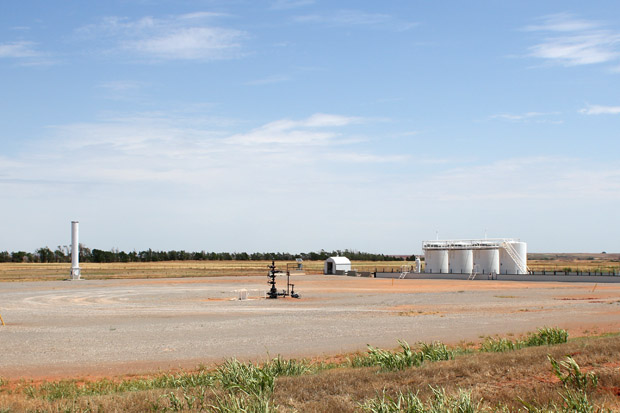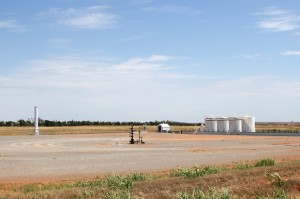
A waste fluid disposal well in western Oklahoma.
Joe Wertz / StateImpact Oklahoma


A waste fluid disposal well in western Oklahoma.
Joe Wertz / StateImpact Oklahoma

Joe Wertz / StateImpact Oklahoma
A disposal well in western Oklahoma.
Oklahoma has experienced an increase in earthquakes in recent years, a phenomenon many geophysicists have linked to disposal wells used by the oil and gas industry.
The 5.7-magnitude quake that injured two people and damaged 14 homes in November 2011 was Oklahoma’s largest on record and is likely the largest triggered by wastewater injection, a team of geophysicists concluded in a report released in March.
Earthquake activity has surged in other states, too, and a study released Thursday suggests a quake boom is following the U.S. energy boom. USA Today’s Dan Vergano breaks down the findings of U.S. Geological Survey geophysicist William Ellsworth:
More than 300 significant earthquakes, ones above magnitude 3, occurred nationwide from 2010 to 2012, a rate of about 100 a year compared with a past average of 21 per year, says the report in the journal Science..
These earthquakes aren’t caused by hydraulic fracturing — or “fracking” — rather the injection of waste fluid generated during regular oil and gas drilling, which can include fracking wastewater. This waste fluid is often toxic, so oil and gas producers inject it deep underground so it won’t contaminate water supplies.
Over time, this injected waste fluid can put pressure on underground fault lines, causing them to slip and trigger earthquakes, seismologists say.
Fault lines loaded up with pressure from disposal wells are also susceptible to quakes on the other side of the planet, another team of seismologists reported in a separate Science.. study. Reuters reports:
Now seismologists at Columbia University say they have identified three quakes – in Oklahoma, Colorado and Texas – that were triggered at injection-well sites by major earthquakes a long distance away.
“The fluids (in wastewater injection wells) are driving the faults to their tipping point,” said Nicholas van der Elst of Columbia’s Lamont-Doherty Earth Observatory in Palisades, New York, who led the study. It was funded by the National Science Foundation and the U.S. Geological Survey.
The February 2010 quake in Chile might have triggered quakes near fault lines in Prague, Okla., which had been pressured by nearby disposal wells, the study shows.
“The fluids are driving the faults to their tipping point,” van der Elst said, tells the Tulsa World‘s Wayne Greene. “The remote triggering by big earthquakes is an indication the area is critically stressed.”
“Typically, where we see triggered earthquakes, we interpret them as earthquakes that were going to happen anyway – they were right around the corner, so to speak,” van der Elst said. “The seismic wave comes by and gives it that extra push or, in this case, that extra squirt of fluid that makes them happen sooner rather than later.”
The van der Elst study was co-written by Katie Keranen, a geophysicist who left the University of Oklahoma for a post at Cornell University.
Oklahoma lawmakers and the Corporation Commission, the state’s oil and gas regulator, have been more passive than other states in writing public safety rules that address disposal well earthquakes.
Oklahoma has thousands of disposal wells and injection-triggered earthquakes are “exceedingly rare,” fracking industry spokesman Steve Everly tells USA Today.
Ellsworth with the U.S. Geological Survey agrees, but “clearly it is happening,” he tells the paper. Ellsworth reiterated the need for more data and monitoring requirements, and a “traffic light system” that would allow states to ease injection if there are signs of earthquakes.
“We also need a system that keeps regional differences in mind with respect to earthquake risk,” Frolich tells the paper. “A magnitude-6.0 quake in West Texas wouldn’t bother anyone, it seems, but one in Dallas would be disastrous.”